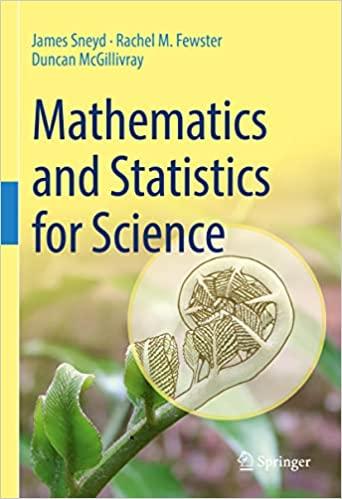Researchers conducted an investigation into the impact of safety adverts on driver behaviour. Either 0, 1, or
Question:
Researchers conducted an investigation into the impact of safety adverts on driver behaviour. Either 0, 1, or 2 large safety adverts were installed on a 5 km stretch of motorway preceding a speed camera. In each case, the adverts were installed for one week, and the number of speeding drivers caught by the speed camera during that week was recorded.
Let Y0, Y1, and Y2 be the number of speeding tickets issued over the weeks with 0, 1, and 2 safety adverts, respectively. Assume that Y0, Y1, and Y2 are independent. We model Yx by Yx ∼ Poisson(βe
−x
), where β > 0 is an unknown parameter to be estimated.
This is another example of a regression model.
Fig. 38.9 shows the graph of E(Yx) = βe
−x for various different values of β. The maximum likelihood estimator for β is
βb=
Y0 + Y1 + Y2 e
0 + e
−1 + e
−2
=
Y0 + Y1 + Y2 Kx
, where the notation Kx = e 0 + e
−1 + e
−2 = 1.5032 is used as shorthand.
The observed data were Y0 = 29, Y1 = 13, Y2 = 3 speeding tickets corresponding respectively to 0, 1, and 2 safety adverts.
The data are plotted with crosses on Fig. 38.9.
a. Describe the model, as shown in Fig. 38.9. Comment on how the model relates the number of speeding tickets to the number of safety adverts, and the impact of larger or smaller values of β on this relationship. What value of β
shown on the plot appears to give the best fit to the observed data?
b. Using the formula above, find the maximum likelihood estimate, βb, for the observed data. Does it agree with your ballpark estimate from part (a)?
c. Find an expression for Var(βb), justifying all your steps
d. Find the standard error, se(βb). Hence find an approximate 95% confidence interval for β.39.1 Let X be a continuous random variable with PDF fX(x) and CDF FX(x). Say whether each of the following statements is true or false. If it is false, give a brief explanation.
a. The shape of the distribution is given by fX(x).
b. fX(x) is a probability between 0 and 1.
c. We can find P(a < X <
b) by integrating FX(x).
d. We can find P(a < X <
b) by integrating fX(x).
e. fX(x) gives the rate at which probability is accumulating at point x.
Step by Step Answer:

Mathematics And Statistics For Science
ISBN: 9783031053177
1st Edition
Authors: James Sneyd, Rachel M. Fewster, Duncan McGillivray





